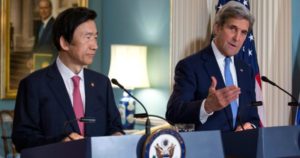
The Daily Signal:
During Wednesday’s bilateral ministerial meeting, Secretary of State John Kerry underscored Washington’s resolve to defend our South Korean ally against missile attacks.
The biennial “2+2 meeting” (secretaries of defense and state with their South Korean counterparts) took place in the shadow of an escalating North Korean nuclear and missile threat. Kerry vowed that the U.S. would deploy the THAAD missile defense system “as soon as possible” to South Korea.
The U.S.-made THAAD is more capable than any missile defense system that South Korea has or will be capable of building for decades. Deploying it to South Korea will enhance allied deterrence and defense capabilities against North Korea’s threats to use nuclear weapons against South Korean targets.
Senior U.S. and South Korean officials affirmed their resolve to deploy THAAD during my private discussions in Seoul last month. China has threatened economic, diplomatic, and military pressure to deter the deployment but South Korean President Park Geun-hye remains resolute. South Korean polls show the majority of the populace remains in favor of THAAD deployment.
North Korea’s Expanding Missile Threat. During Kim Jong-un’s four-year reign, Pyongyang has conducted more than twice as many missile tests as his father Kim Jong-il did in 18 years in office. In 2016, North Korea has engaged in a rapid-fire series of nuclear and missiles tests, significantly expanding and augmenting the nuclear threat to the United States, South Korea, and Japan. This year, Pyongyang successfully conducted two nuclear tests, an intercontinental ballistic missile test, and breakthrough successes with its submarine-launched ballistic missile (SLBM) and Musudan road-mobile intermediate-range missile (IRBM).
Based on these successes, as well as regime disclosures of missile program information, the South Korean government and outside experts now believe that North Korea’s SLBM and Musudan could be deployed within one year, rather than 3-4 years as previously assessed.
